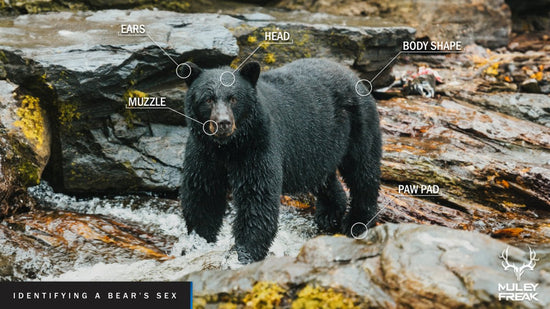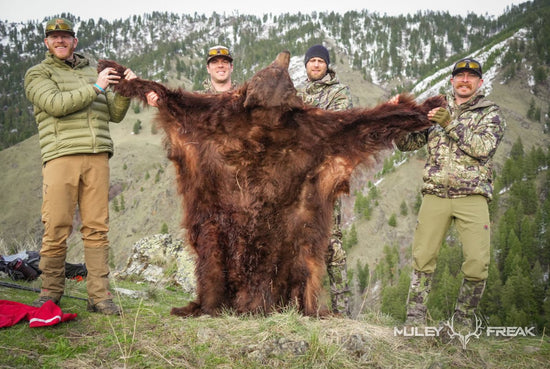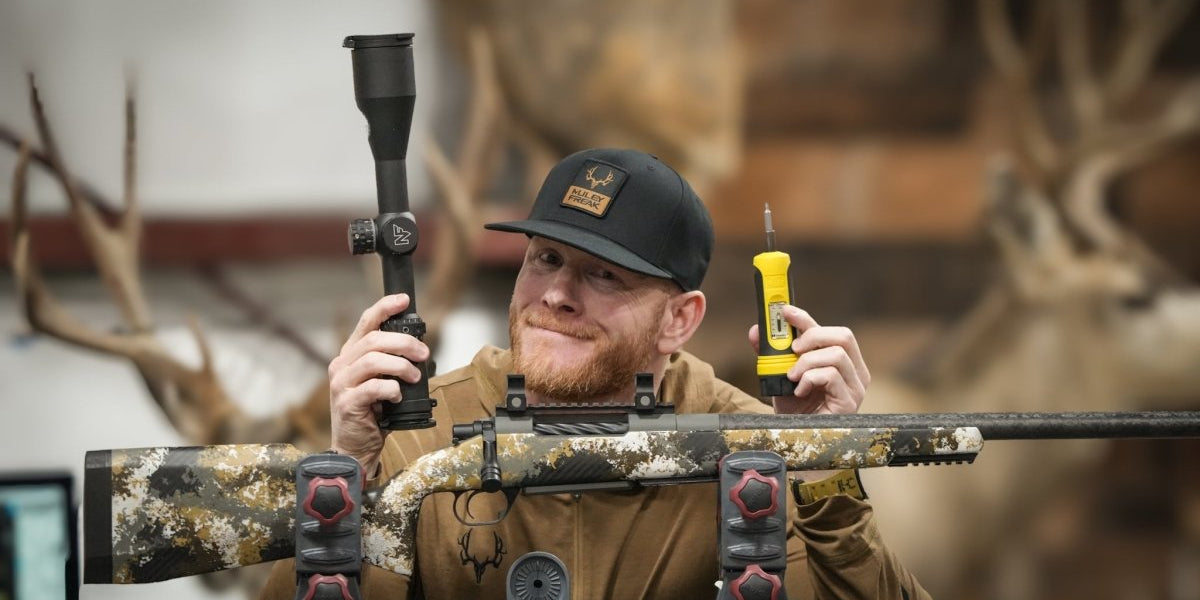Table of Contents
Bear Shot Placement: Where You Should Shoot A Bear
If you consume bear hunting content you've likely heard hunters talk about the bear they lost after what was thought to be a well-placed shot. Such stories are often riddled with statements like, "Bears don't bleed much" and "Shot placement on a bear is much different than a deer or elk."
Our bear hunting journey at Muley Freak is an adult on-set journey. We didn't grow up hunting bears and when we decided bear hunting was something we wanted to do, we gathered as much information as possible through talking to veteran hunters, reading articles online and in magazines, and watching as many videos as we could find. And now as experienced bear hunters, we've found the statements above hold credence, bears are different. In this article, we want to add our philosophy and findings to why bear hunters say shooting a bear is such a unique experience. We're also going to dive into the fine details of bear physiology and anatomy so you as a new or seasoned bear hunter can make the most accurate and lethal shot.
Although some general similarities do exist between big game and bear shot placement, some differences also exist and could be the difference between losing and recovering a bear. For example, the old “shoot them behind the shoulder” statement is generally true. But with the facts we lay out below you’re going to want to tweak exactly where you shoot a bear behind the shoulder.
Bear Anatomy vs. Mule Deer Anatomy

First and foremost is knowing the anatomy of a bear. Knowing where to place the shot and the difference between the anatomy of a bear versus a deer or an elk is of the utmost importance because it isn’t the same.
Deer and elk are built with large-capacity lungs for running from predators and can sustain long distances. According to MeatEater, unlike deer and elk, black bears are built for quick bursts of speed (as high as 30 mph) over short distances meaning their lungs are smaller.

The bone structure around an animal's lungs differs from big game to bears. The lungs of a deer or an elk are partially covered and protected by their scapula. A bear’s lungs are further back and lower, sitting free of the scapula.

How To Bear Shot Placement: Make A Broadside Shot On A Bear

Considering this information about a bear's lung anatomy, a broadside shot is excellent shot placement. This shot will give you the greatest access to a bear’s lungs and also the heart. If a bear is standing broadside their heart sits low in their chest and behind the shoulder. As mentioned before, the lungs sit behind the shoulder and lower than where they would sit on a deer or elk.

Because of a bear's lung anatomy, if your shot placement is too high you have a high probability of a miss to the lungs and other organs. This same shot placed high on a deer or elk is much more forgiving than a bear and most likely would end up with a high lung hit and a dead animal because of how high the lungs go up in the body cavity of Big Game. I’ve witnessed multiple bears get hit high behind the shoulder and they were either lost, needed another bullet in them, or took longer to die than is ideal.

If you are solely aiming for the heart, proceed with caution. A common mistake bear hunters make is shooting too low and completely missing the vitals. Bears have lots of fat and thick fur which makes it difficult to pinpoint exactly where the fur, fat, and the body meet (see the above graphic for reference). A safe aiming point is to go to the middle of the body, midway between its back and belly (that’s often referred to as the mid-mid or middle-middle), and then move back towards the shoulder two to three inches.
Another reason to seriously consider and patiently wait for a broadside shot, especially when bow hunting, is because a complete pass-through shot will provide better blood for tracking.
A complete pass-through shot has a higher probability of bleeding well without fur and fat plugging the hole. I’ve heard a handful of hunters say they shot a bear perfectly but never found more than a few drops of blood. Be patient and wait for broadside shots if you can, especially while bowhunting.
Bear Shot Placement: How To Make A Quartering-Away Shot On A Bear

A quartering-away shot is another deadly shot when properly placed. Again, knowing their vitals sit further back, pick the last rib as your aiming point. Inexperienced bear hunters may believe this shot is too far back based on experience with deer and elk shot placement, but it will be a perfect shot on a bear. Aiming too far forward on a quartering-away bear could lead to wounding a bear and never seeing it again.
The quartering-away has actually become a favorite shot of mine - I've harvested 3 bears this way with almost zero tracking necessary. A few years ago on our Bonsai Bears 2.0 trip I placed a bullet behind a giant chocolate bear’s last rib and after taking five or six steps he started rolling and ended up in the bottom of the canyon. This shot placement allows the greatest opportunity for the bullet to run through multiple vitals (guts, liver, lungs, etc…). Another reason to take a quartering-away shot is so you have the best opportunity to damage an essential organ, the diaphragm. By destroying the diaphragm you take away the animal’s ability to control air pressure in their chest which results in lung failure.

One thing to remember though is, a quartering-away shot will likely not give you a lot of blood for tracking, but it sure does cause catastrophic damage and often leads to bears going down quickly.
Bear Shot Placement: How To Make A Frontal Shot On A Bear

Frontal shots are a great option too. The greatest opportunity is when they are sitting on their butt in a dog-like position. Sitting like this opens up the sweet spot and gives you the largest target radius on the chest. If the bear is standing, the sweet spot window is much reduced and part of their neck or head may even cover where you want the bullet or arrow to impact.
The closer you are to the bear the better when taking a frontal shot. Bait site bear hunters have the highest likelihood of being close and having a sitting bear for the best frontal shot. With that being said, Muley Freak Erik made an awesome frontal shot on a standing big boar a few years ago in Montana. Erik was very close and the bear's head was held high in the air giving him a great target (see above photo).
Just know, the further away you are the harder it is to hit the small sweet spot on a frontal shot. Like most shots, it is much easier to make this happen with a rifle as you must hit almost perfectly center with a bow.
Bear Shot Placement: How To Make A Quartering-To Shot On A Bear

In my opinion, the quartering-to shot gives you the greatest chance for error, especially with a bow, because of the high chance for deflection off heavy shoulder bones or ribs. If the bullet or arrow does not deflect and ends up penetrating, it may not give you the penetration needed to kill the animal or give you good blood to track. In our opinion, stay away from this shot.
If you do feel the need to take this shot and are hunting with a rifle, find the crease where the shoulder and body cavity meet and aim just behind it, trying to make sure you miss the shoulder bone and hit those vitals sitting further back in a bear's body cavity. This should be a lethal shot as long as you hit where you aim and the bullet performs properly. Other hunters may tell you to aim just right of the shoulder bone towards the chest, which will also be fatal so long as you hit just right.
Bear Shot Placement: How To Make A High-Shoulder Shot On A Bear

I mentioned earlier the safest way to shoot a bear is to go middle-middle and then two to three inches toward the shoulder. This high shoulder shot when performed properly will completely eliminate the need for tracking and is a piece of mind knowing bears don’t always leave a good blood trail.
Just like on a deer or elk, the high shoulder shot can and will drop a bear right in its tracks, but as we all know, knocking an animal down doesn’t mean they are dead. Caution must be taken when making this shot and avoid hitting too high, or too far forward and missing vitals. Again, a bear’s vitals sit farther back so making sure you hit right in the middle of the shoulder is key to causing trauma to important vessels running to and from the heart.
A great example of the execution of this shot is when Erik dropped a 20+-year-old giant sow in Colorado right in her tracks. She came out of the thick vegetation to snack on Erik’s elk carcass and Erik sent a 212 gr Hornady ELD-X right between her shoulder blades. She didn’t go an inch.

I’ve also witnessed black bears get away when the shot was placed too far forward or too high.
In Summary: Do Not Make These 5 Mistakes
Mistake #1:
- Do NOT aim at the heart and miss the bear low. Remember, bears have an abundance of fat and fur so it can be difficult to tell exactly where the body cavity sits. It’s better to aim “mid-mid” and touch back to the shoulder, rather than intentionally trying to shoot the heart.
Mistake #2:
- Do NOT hit too far forward on a quartering-away bear. This will likely lead to a wounded bear that you won’t ever see again. Remember, the vitals of a bear sit farther back than a deer or elk’s vitals, so aim at the last rib instead.
Mistake #3:
- Do NOT take a frontal shot on a bear if it’s not in the optimal position. Oftentimes a bear’s head will be covering the sweet spot on his chest, and the sweet spot on a frontal-positioned bear is not very big. Even if the bear is in a good position, hitting dead center on his chest is difficult. Instead, you may consider waiting for it to either sit down on its back legs, lift its head, or move to another position.
Mistake #4:
- Do NOT bounce a broad-head or bullet off a quartering-to-positioned bear’s shoulder bone. Shooting at a bear when it is positioned this way presents a real risk of deflection. Either wait for the bear to switch positions, or aim just behind the crease where the shoulder meets the body.
Mistake #5:
- Do NOT shoot too high when trying to make a high-shoulder shot. As stated at the very beginning of this article, the vitals of a bear sit lower than a typical big game animal. There’s no doubt that you will knock the bear to its belly with a shot too high, but there is a good chance it will get up and head out of town afterward.
Another valuable skill to have while bear hunting is learning how to identify a bear's sex. You can learn how in our latest article below.








Very interesting data submitted by people way more qualified on bear hunting than me, however all discussion is based on bullet entry location, I believe some focus should be applied to bullet travel (exit) as you now can visualize which organs will be hit.